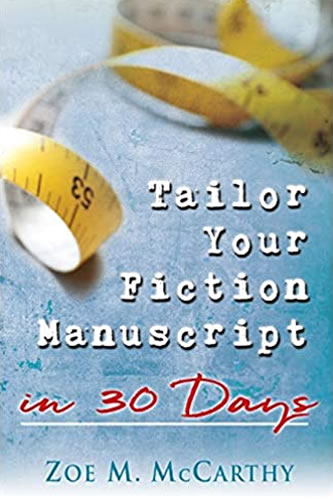


Tailor Your Fiction Manuscript in 30 Days is chock-full of practical techniques. Numerous examples clarify problem areas and provide workable solutions. The action steps and blah busters McCarthy suggests will help you improve every sentence, every paragraph of your novel. If you follow her advice and implement her strategies, a publisher will be much more likely to issue you a contract. —Denise K. Loock, freelance editor, lightningeditingservices.com
See more about the book at the end of the post.
I’m writing the second chapter of my new book. As I’ve been writing it, I realized how thankful I am that I have the major plot points already sketched out. Instead of winging it, I use the Hero’s Journey to do this, but any plotting method will do. My upfront plotting is mostly high-level with scene ideas thrown in as I receive them.
Benefits of Being a Plotter Before Writing
- I have a good idea of what research is needed. When I’m the passenger on car trips or sitting in a waiting room, I can get research done ahead of time. Then I don’t have to interrupt my story writing time as much to research.
- Ideas for my stories come to me when I’ve turned in for the night. Knowing the storyline, I receive ideas for foreshadowing events that I already know will happen later in the story.
- I already understand much about my protagonists and some secondary characters—their personalities, natures, dispositions, and temperaments. I have an idea how they’ll probably approach and handle conflicts and disasters I’ve sketched out.
Benefits of Being a Panster While Writing
- I don’t plot the nitty-gritty matter like some plotters do—create detailed settings (map out the town), characters (know their favorite color and how it changed from pink to blue), and the events (viewing them from every character’s point of view).
- Once I have my plot sketch, I allow myself to be free to write each scene as my creativity directs. This means ideas in my sketch may be changed if the change strengthens a plot point. For example, A hero’s job might change from an accountant for a large firm in the sketch to an accountant for the IRS to make a better reason why he’d want to quit his job.
- I feel free to write the scenes by the seat of my pants because I always have my back-up sketch to turn to. After I finish a scene, I look at my sketch to see if I missed any ideas that added to the story’s goals, conflict, or motivations.
What Makes Being a Hybrid Work for Me
I never feel bound to the sketch, especially on the smaller ideas I’ve thrown in, but I have always used the high-level events for the:
- Ordinary World
- The Call to Adventure (and the Inciting Incident)
- Refusal of the Call
- Meeting the Mentor
- Crossing the Threshold
- Tests Allies & Enemies
- Approaching the Inmost Cave
- Ordeal, Death, and Rebirth
- Seizing the Reward
- The Road Back
- Resurrection
- Return with the Elixir
Which are you, plotter, panster, hybrid or something else? Why?

I finished reading Tailor Your Fiction Manuscript in 30 Days. I have AND will highly recommend it to anyone who dabbles in fiction. It’s one of the best “how to” books I’ve ever read.
—Marsha Hubler, Director Montrose Christian Writers Conference
If you want to increase your chance of hearing yes instead of sorry or not a fit for our list at this time, this book is for you. If you want to develop stronger story plots with characters that are hard to put down, this book is for you. Through McCarthy’s checklists and helpful exercises and corresponding examples, you will learn how to raise the tension, hone your voice, and polish your manuscript. I need this book for my clients and the many conferees I meet at writer’s conferences around the country. Thank you, Zoe. A huge, #thumbsup, for Tailor Your Fiction Manuscript in 30 Days.
—Diana L. Flegal, literary agent, and freelance editor
Tailor Your Fiction Manuscript is a self-editing encyclopedia! Each chapter sets up the targeted technique, examples show what to look for in your manuscript, then proven actions are provided to take your writing to the next level. Whether you are a seasoned writer or a newbie, you need this book!
—Sally Shupe, freelance editor, aspiring author
Need to rework your book? Zoe M. McCarthy’s step-by-step reference guide leads you through the process, helping you fight feeling overwhelmed and wrangle your manuscript into publishable shape in 30 days. Tailor Your Manuscript delivers a clear and comprehensive action plan.
—Elizabeth Spann Craig, Twitteriffic owner, bestselling cozy mystery author of the “Myrtle Clover Mysteries,” the “Southern Quilting Mysteries,” and the “Memphis Barbeque Mysteries,” http://elizabethspanncraig.com/blog/
Zoe’s book, Tailor Your Fiction Manuscript in 30 Days, is a fresh and innovative refocusing of your novel or novella. Through a few simple—and fun—steps, Zoe helps writers take their not-ready-for-publication and/or rejected manuscripts to a spit-polish finish. Writing is hard work, yes, but it doesn’t have to be difficult.
—Eva Marie Everson, best-selling and multiple award-winning author, conference director, president of Word Weavers International, Inc.
A concise, detailed, step by step resource for all writers.
— Jamie West, editor coordinator, Pelican Book Group
Zoe’s writing blog has always intrigued me. As a high school English teacher, I can attest that her tips on good grammar and her hints for excellent sentence and paragraph structure are spot on. But as an author, I also appreciate her ever-present advice that excellent skills are not enough: you must tell a good story, too. This book clearly shows how to do it all.
—Tanya Hanson, “Writing the Trails to Tenderness,” author of Christmas Lights, Outlaw Heart, Hearts Crossing Ranch anthology, and coming in 2019, Tainted Lady, Heart of Hope, and Angel Heart. www.tanyahanson.com
McCarthy crafted an amazing self-help book that will strengthen any writer, whether new or seasoned, with guidance and self-evaluation tools.
–Erin Unger, author of Practicing Murder, releasing in 2019
Zoe has developed a guiding resource for beginning writers. Her method is designed for brainstorming, shaping, and revising an early draft of a manuscript. General and specific tips are offered for applying rules of writing to enhance one’s story for a workable second draft. By exploring the plot line of Love Comes Softly writers may examine their own work for stronger plot and characterization. Valuable tools are offered that enable the writer to develop a workable draft in 30 days!
—Yvonne Lehman, award-winning, best-selling author of 48 novels



 RSS - Posts
RSS - Posts



I’m definitely a blend of plotter and pantser. Like you, I need a direction but details as I get into the story tend to evolve.
A hybrid sister! Thanks for commenting, Sally.